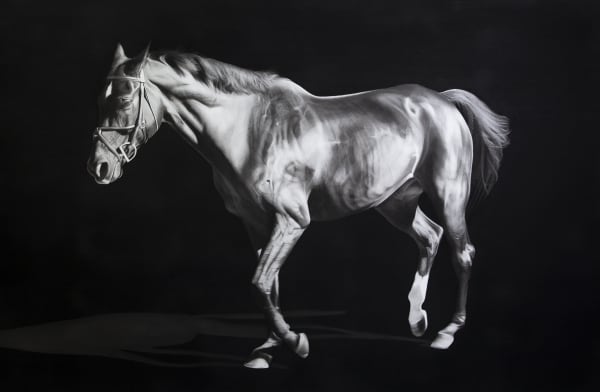"CHEVAUX" LUISI MERA: Paris
Past exhibition
Press release
Stems presents its inaugural exhibition of acclaimed Panamanian artist, Luisi Mera, in a collection titled Chevaux. This exhibition showcases a series of seven large-scale charcoal drawings.
Ours is a culture in breathless pursuit of legible, static personhood. If the self can be mythologized, we reason, then perhaps it can be possessed. The artist Luisi Mera quietly pushes back against this dominant narrative, wielding her subjectivity in the service of something larger than either herself or this distinct moment in time. Which is to say, her sense of history is acute; she endeavors to honor both the past and future by establishing a point of visual continuity between the two. Mera accomplishes this by homing in on a subject matter central to the art historical canon, the horse.
The earliest known depictions of horses date back to the Lascaux Cave Paintings in France, approximately 16,000 years ago. Crudely rendered in charcoal and ochre, these horses are emblems of humanity’s emergent consciousness, its drive toward replication and mastery. As history unfolds, man domesticates his fellow creatures, whose strength aids in the development of civilization, and art evolves into a discipline with increasingly sophisticated social and economic functions. All the while, artists take on the equine form. Old Masters, such as Giotto, Albrecht Dürer, Andrea Mantegna, and Leonardo da Vinci, render its musculature with exquisite precision; modern artists, such as Degas, Matisse, Picasso, Giorgio de Chirico, Andy Warhol, and Jean-Michel Basquiat imagine radical new means of its representation.
With Chevaux, Mera joins this long lineage of artists. The series depicts three real-life equestrian horses—Caballo, Cayetano, and Flinka—for whom she traveled, sometimes great distances, to study. (It was important to the artist to begin her portraits with live drawings, in order to fully comprehend her subjects’ anatomies.) Her beguiling, outsized drawings evince her unabashed appreciation not only for the sublime creatures, but also for her predecessors. Synthesizing the new and old, she executes a contemporary style through a medium popularized in the nineteenth-century, charcoal. Each piece in the series was executed with a single shade of deep black charcoal. Wielding this stick against white paper, Mera painstakingly excavated her equine figures.
Mera’s laborious practice further evinces her classical sensibility: Charcoal drawings of such proportion demand immense technical expertise and physical tenacity. Kneeling on top of her drawings, Mera nimbly redistributes her body’s weight, applying finely tuned degrees of pressure onto the stick and erasing excess density. This process of addition and removal enables her to manipulate the interplay between light and shadow, attaining variations in shade as a result. In these maneuverings of controlled elegance, Mera is aided by her extensive training as a ballet dancer. She finds this embodied process deeply meditative, peaceably working twelve-hour days.
Positioned amid an expanse of black, Mera’s completed horses are decontextualized from their pastoral settings. The indexes of domestication that they bear—bits, bridles, and branded lettering—appear somewhat absurd as a result. The drawings’ high-contrast lighting and smooth texture also contributes to the series’ uncanny quality. Spectral in their illumination, the works evoke daguerreotype photography, but the horses’ pronounced veins and muscles indicate the intervention of a more precise instrument. That the high-definition instrument in question is Mera’s hand astounds.
In one sense, the drawings in Chevaux align with the contemporary ethos; in this age of photoshop and AI, Mera’s drawings appear too good to be true, so realistic as to seem fake. In another, they harken back to the most primitive of humanity’s expressions, the charcoal and ochre figures painted in caves. Mera’s drawings serve as a reminder that we are still grappling in the dark, taking stabs at self-articulation. Our efforts are often beautiful and impressive, but never complete.
– Caroline Reagan
Installation Views
Works
-
 Luisi MeraCayetano I , 2023Charcoal on paper mounted on wooden panel91.4 x 121.9 cm.
Luisi MeraCayetano I , 2023Charcoal on paper mounted on wooden panel91.4 x 121.9 cm.
36 x 48 in. -
 Luisi MeraCayetano II, 2023Charcoal on paper mounted on wooden panel91.4 x 121.9 cm.
Luisi MeraCayetano II, 2023Charcoal on paper mounted on wooden panel91.4 x 121.9 cm.
36 x 48 in. -
 Luisi MeraCayetano III, 2023Charcoal on paper mounted on wooden panel121.9 x 182.9 cm.
Luisi MeraCayetano III, 2023Charcoal on paper mounted on wooden panel121.9 x 182.9 cm.
48 x 72 in. -
 Luisi MeraCaballo I, 2023Charcoal on paper mounted on wooden panel91.4 x 121.9 cm.
Luisi MeraCaballo I, 2023Charcoal on paper mounted on wooden panel91.4 x 121.9 cm.
36 x 48 in. -
 Luisi MeraCaballo II, 2023Charcoal on paper mounted on wooden panel121.9 x 182.9 cm.
Luisi MeraCaballo II, 2023Charcoal on paper mounted on wooden panel121.9 x 182.9 cm.
48 x 72 in. -
 Luisi MeraCaballo III, 2023Charcoal on paper mounted on wooden panel152.4 x 243.8 cm.
Luisi MeraCaballo III, 2023Charcoal on paper mounted on wooden panel152.4 x 243.8 cm.
60 x 96 in. -
 Luisi MeraFlinka, 2023Charcoal on paper mounted on wooden panel182.9 x 121.9 cm.
Luisi MeraFlinka, 2023Charcoal on paper mounted on wooden panel182.9 x 121.9 cm.
72 x 48 in.







